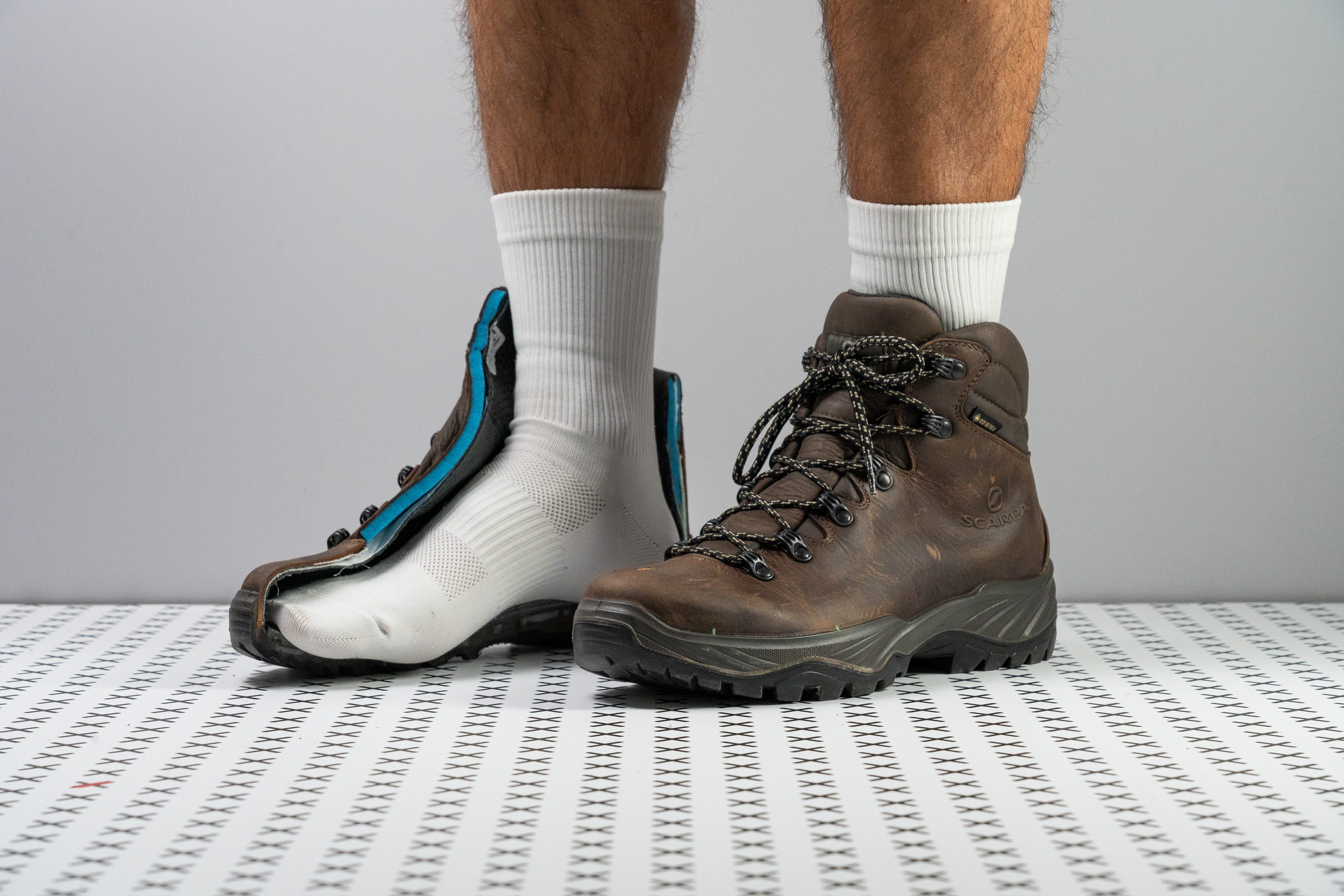Our verdict
- Top pick in best hiking boots
- Top pick in best leather hiking boots
Pros
- Glue-like underfoot, even on wet surfaces
- Insanely comfortable
- Reliably stable and supportive ride
- Resilient and high-quality build
- Durable Vibram outsole
- Watertight and warm
- Quick break-in time
- Performs consistently in the cold
- Strong ankle support
Cons
- Quite heavy
- Cushioning could be better
- Scuff magnet
Audience verdict
- Top 3% in hiking boots
- Top 25% in Scarpa hiking boots
Comparison
The most similar hiking boots compared
+ + Add a shoe | |||||
|---|---|---|---|---|---|
| Audience score | 95 Superb! | 77 Decent! | 90 Great! | 88 Great! | |
| Price | $249 | $229 | $200 | $200 | |
| Trail terrain | ModerateTechnical | ModerateTechnical | LightModerate | ModerateTechnical | |
| Shock absorption | - | - | Moderate | Moderate | |
| Energy return | - | - | Moderate | Low | |
| Weight lab Weight brand | 20.3 oz / 575g 19 oz / 539g | 20.6 oz / 583g 20.6 oz / 585g | 18.7 oz / 529g 19.5 oz / 553g | 14.6 oz / 415g 16.6 oz / 470g | |
| Lightweight | ✗ | ✗ | ✗ | ✓ | |
| Breathability | Warm | Warm | Moderate | Warm | |
| Use | Day HikingSnow | BackpackingDay HikingSnow | Day HikingUrban hikingSnow | BackpackingDay HikingSnow | |
| Orthotic friendly | ✓ | ✓ | ✓ | ✓ | |
| Drop lab | 15.1 mm | 14.0 mm | 13.8 mm | 14.1 mm | |
| Size | True to size | Slightly small | True to size | Half size small | |
| Midsole softness | Balanced | Balanced | Balanced | Balanced | |
| Difference in midsole softness in cold | Small | Small | Normal | Normal | |
| Heel counter stiffness | Moderate | Moderate | Moderate | Moderate | |
| Stiffness | Stiff | Moderate | Moderate | Moderate | |
| Outsole hardness | Hard | Hard | Average | Very hard | |
| Waterproofing | Waterproof | Waterproof | Waterproof | Waterproof | |
| Material | Leather | Suede | Suede | Textile | |
| Season | Winter | Winter | - | Winter | |
| Toebox durability | Good | Good | Good | Good | |
| Heel padding durability | Decent | Decent | Bad | Decent | |
| Outsole durability | Decent | Good | Decent | Good | |
| Width / fit | Medium | Medium | Medium | Medium | |
| Toebox width | Narrow | Narrow | Medium | Medium | |
| Lug depth | 4.0 mm | 4.0 mm | 4.0 mm | 4.3 mm | |
| Heel stack lab | 32.1 mm | 34.2 mm | 36.8 mm | 34.4 mm | |
| Forefoot | 17.0 mm | 20.2 mm | 23.0 mm | 20.3 mm | |
| Widths available | Normal | Normal | NormalWideX-Wide | NormalWide | |
| Technology | Gore-TexVibram | Gore-TexVibram | OrtholiteVibram | Gore-TexOrtholite | |
| Cut | High cut | Mid cut | Mid cut | Mid cut | |
| Removable insole | ✓ | ✓ | ✓ | ✓ | |
| Ranking | #1 Top 3% | #39 Bottom 4% | #5 Top 13% | #15 Top 37% | |
| Popularity | #21 Bottom 48% | #41 Bottom 1% | #6 Top 15% | #2 Top 5% |
Who should buy
We recommend the Scarpa Terra GTX as an excellent choice for:
- Cold-weather adventurers in the market for a waterproof leather boot that's cozy and warm
- Hikers who prioritize strong grip and want a boot that can tackle wet surfaces with confidence
- Those who need strong ankle support when traversing uneven terrains
- Backpackers looking for a boot that feels stable under the burden of a heavy pack
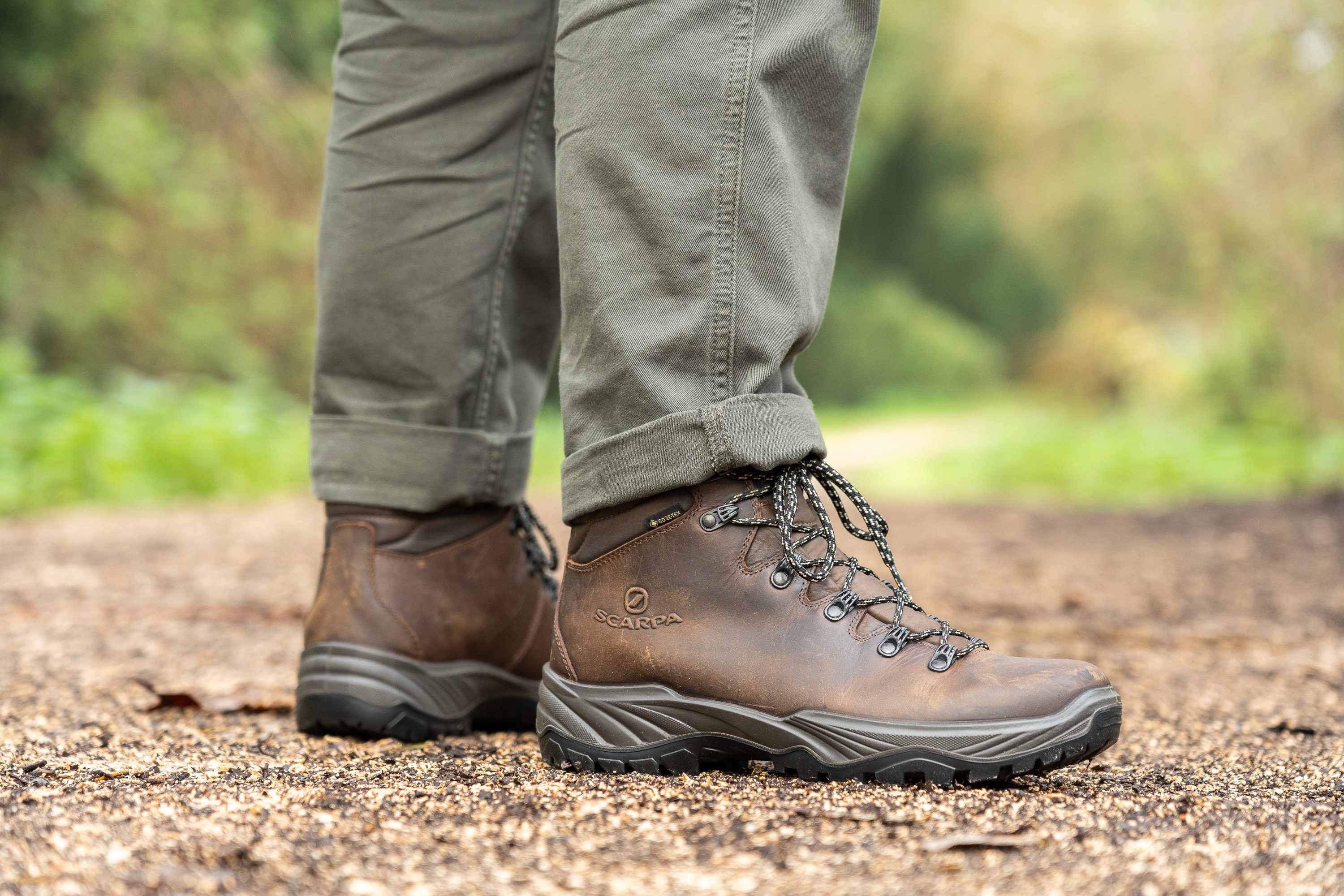
Who should NOT buy
While the boot's upper feels incredibly luxurious with its generous and well-placed padding, the same can't be said of the midsole which is rather firm underfoot. For those who prefer boots with softer cushioning, we recommend the KEEN Pyrenees which also boasts a nubuck leather upper.
We found the Terra GTX to be quite heavy compared to other hiking boots, so hikers who prefer a lightweight companion for their longer or speedier jaunts through nature will be better served with a lighter option like the Merrel Moab Speed Mid GTX or the Timberland Euro Hiker.
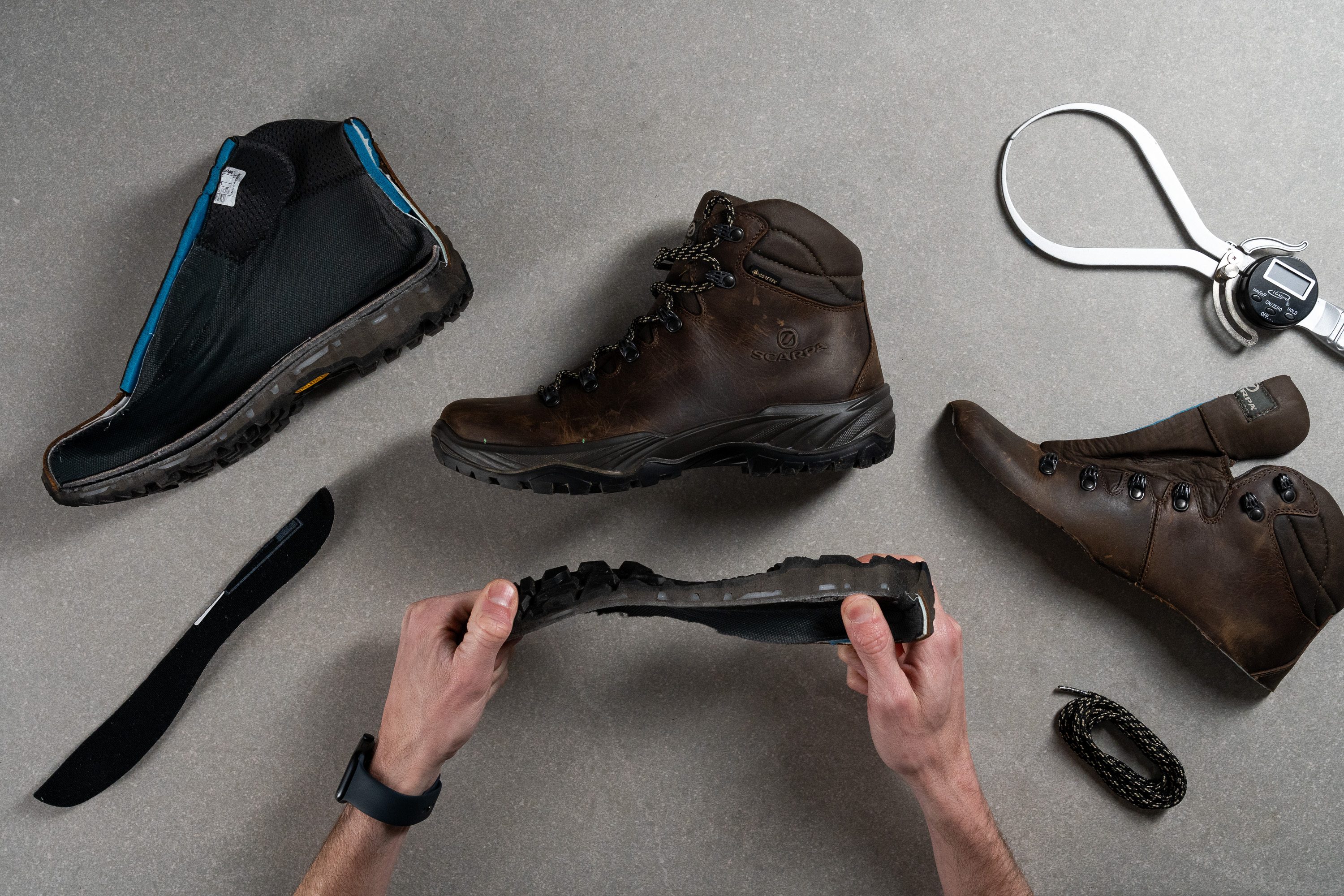
Broad-footed hikers will find that there isn't much wiggle room for the toes in the Terra GTX. For a roomier alternative, we recommend looking into the Salomon Quest 4 GTX instead.
Cushioning
Heel stack
At 32.1 mm thick according to our caliper measurements, the Terra GTX's stack is shorter than average at the heel.
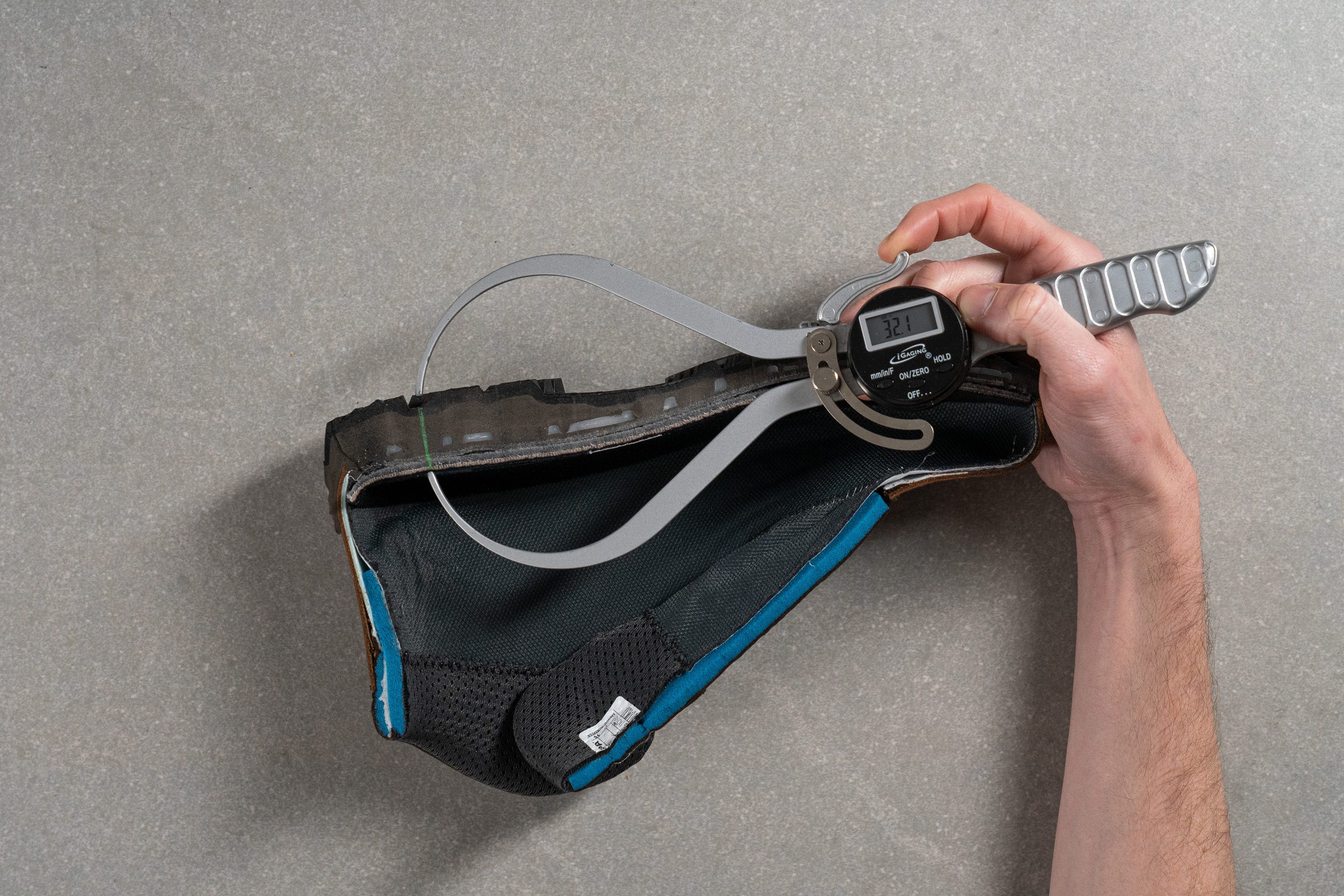
This is still enough foam and rubber underfoot that our landings felt well dampened and protected as we tested the boot over various types of terrain.
| Terra GTX | 32.1 mm |
| Average | 36.3 mm |
Forefoot stack
The Terra GTX's stack is also significantly shorter than average at the forefoot which is only 17 mm thick according to our caliper.
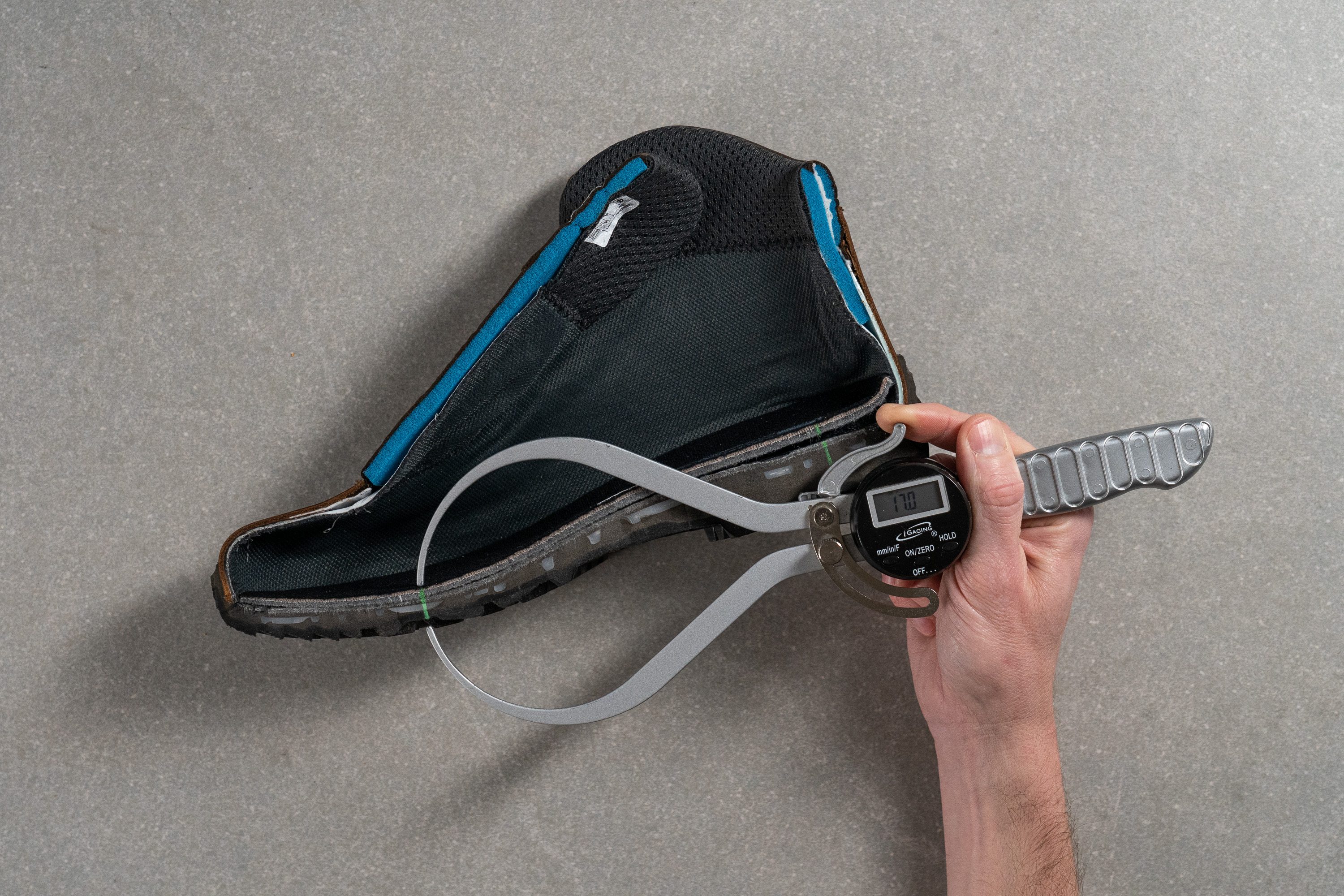
While this provides minimal cushioning in this part of the boot, this low profile means that we enjoy an intuitive sense of the surface below which keeps us feeling grounded and stable even as we traverse uneven terrains in this boot.
| Terra GTX | 17.0 mm |
| Average | 23.0 mm |
Drop
The difference in our stack measurements leaves us with a rather steep offset of 15.1 mm. This shouldn't be too jarring for most hikers and will feel quite comfortable as it provides a good mix of an elevated and protected heel with a high level of ground feel.
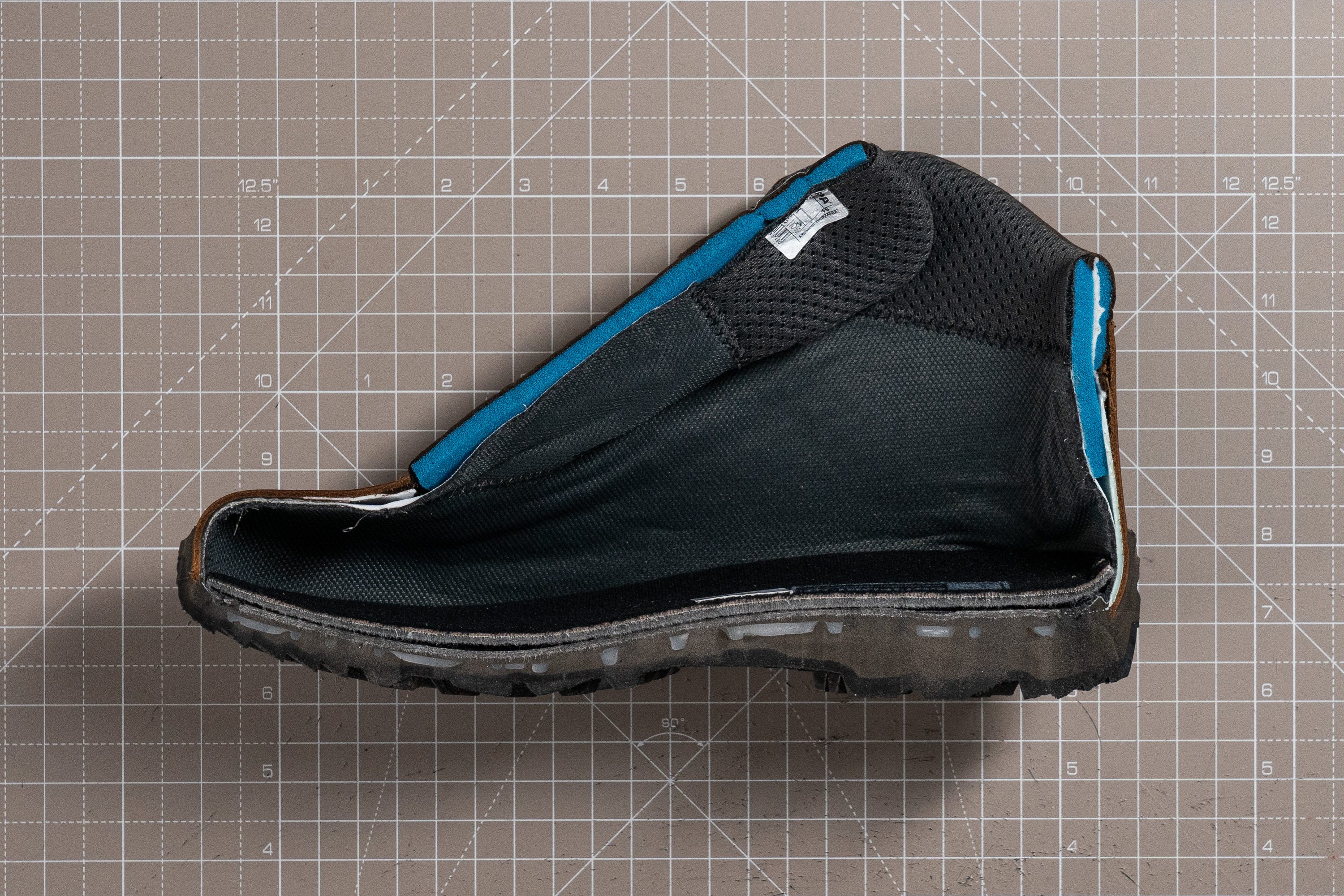
However, those who want a more parallel-to-the-ground experience should consider an alternative with a much lower heel drop like the Altra Lone Peak Hiker 2.
| Terra GTX | 15.1 mm |
| Average | 13.3 mm |
Midsole softness
The injected PU midsole foam gives us a rather firm durometer reading of 29.5 HA.

This level of firmness imparts a good deal of stability to our strides and effectively protects our feet from impact, though it's far from pillowy and springy. In other words, the Terra GTX doesn't feel as luxurious underfoot as its generously padded and exquisite interior would lead us to believe. On the other hand, this stable ride made the Terra GTX a good beast of burden whenever we were schlepping heavy packs as it doesn't compress or feel wobbly under the added weight.
For hikers in the market for a well-padded boot that boasts softer cushioning for a more forgiving ride, we recommend checking out the Hoka Kaha 2 GTX or the KEEN Pyrenees instead.
| Terra GTX | 29.5 HA |
| Average | 28.4 HA |
Size and fit
Size
Scarpa Terra GTX fits true to size (68 votes).
Width / Fit
Using our caliper, we measured the Terra GTX's toebox to be 102.4 mm wide at its widest point. This puts the boot in line with our current lab average and means that it should accommodate those with narrow to medium feet quite comfortably.
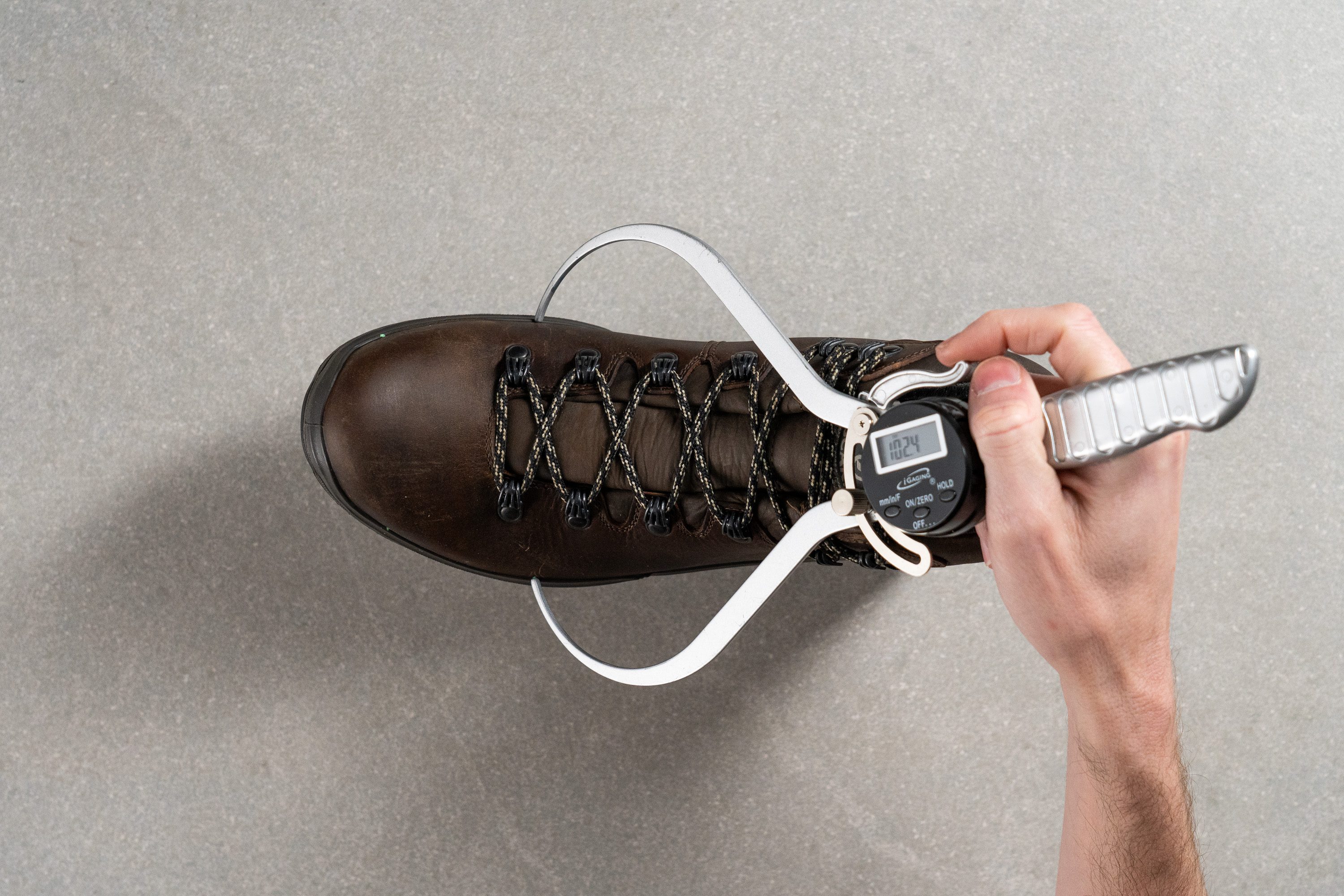
This might feel a little too snug for broad-footed individuals who will be better served with a boot with some more internal real estate like the Salomon Quest 4 GTX instead.
This test follows an older methodology, which is why you don't see recently tested shoes in the chart. Results from different methodologies can not be compared.
| Terra GTX | 102.4 mm |
| Average | 102.1 mm |
Toebox width
The toebox tapers quite significantly towards the big toe, becoming only 75.6 mm wide at the big toe according to our caliper.

The aforementioned Salomon Quest 4 GTX also boasts added toe room for those with wide feet, as does the Danner Mountain 600 which will provide a better fit for those who don't need a particularly wide toebox.
This test follows an older methodology, which is why you don't see recently tested shoes in the chart. Results from different methodologies can not be compared.
| Terra GTX | 75.6 mm |
| Average | 78.6 mm |
Traction / Grip
Lug depth
We measured the lugs to be 4 mm thick which is right on par with our current lab average.

This doesn't tell the full story though, their multi-shaped and multi-directional orientation along the outsole gave us good traction and braking power over all sorts of terrains.
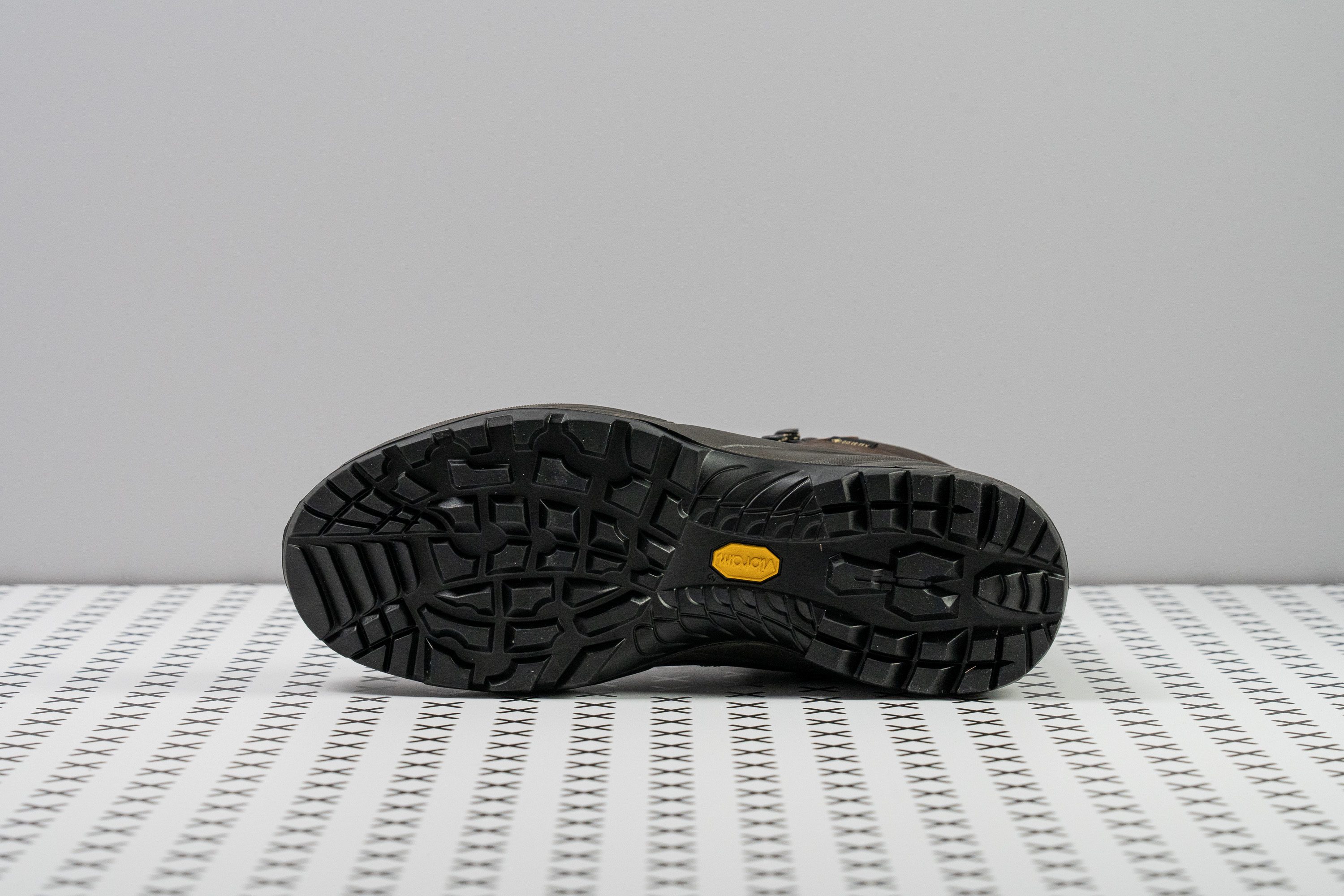
What's more, the Vibram rubber compound is extremely grippy to the point of almost feeling adhesive. Even descending wet hilly paths were no cause for concern while testing this boot.
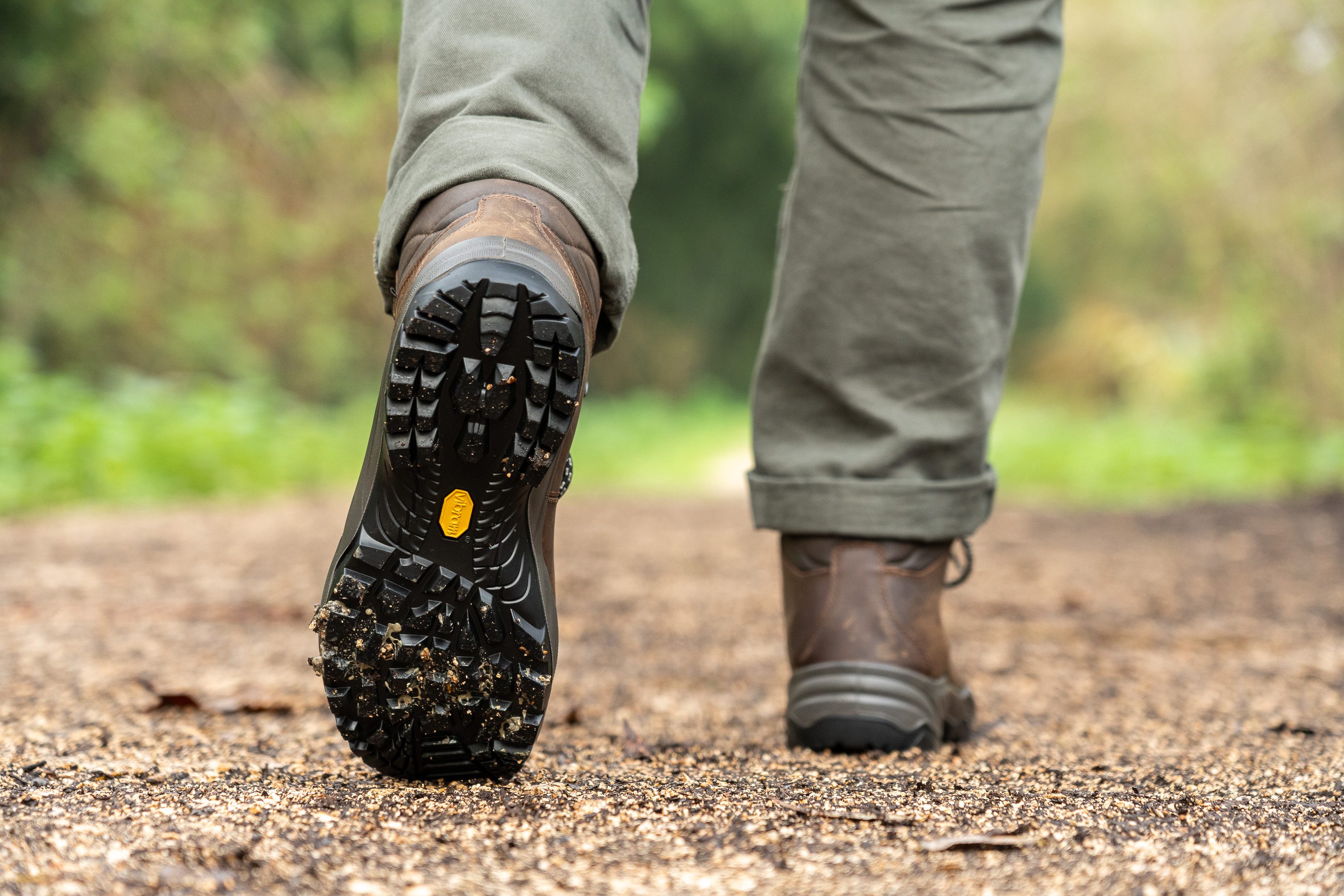
| Terra GTX | 4.0 mm |
| Average | 4.3 mm |
Flexibility / Stiffness
With the stiff shank and dense midsole, it's no surprise that the Terra GTX isn't as flexible as the average hiking boot. After strapping it to our workbench, we found that 47.1N of force is needed to bend the boot to 90 degrees.
This doesn't do enough to hamper just how comfy these boots are, with this resistance to the natural flexion of our foot feeling rather supportive as it prevents our foot from wrapping around every tree root and obstacle we step on. This helps in reducing foot fatigue and means that we didn't feel as sore as we'd expected after a long hike.
This test follows an older methodology, which is why you don't see recently tested shoes in the chart. Results from different methodologies can not be compared.
| Terra GTX | 47.1N |
| Average | 44.3N |
Stiffness in cold (%)
We also repeated the flex test after leaving the boot in the freezer for twenty minutes and found that it only became 18.5% stiffer when chilled. This means that, like the midsole cushioning, the flexibility of the boot isn't as prone to cold conditions as the average hiking boot. As such, the Terra GTX will make a great year-round companion for outdoor enthusiasts who don't let a bit of frost get in the way of their adventurous spirit.
| Terra GTX | 19% |
| Average | 24% |
Weight
Which brings us to the weigh-in and, tipping our scale at 20.3 oz (575g), the Terra GTX is undeniably chunky and heavier than the average mid-length boot.
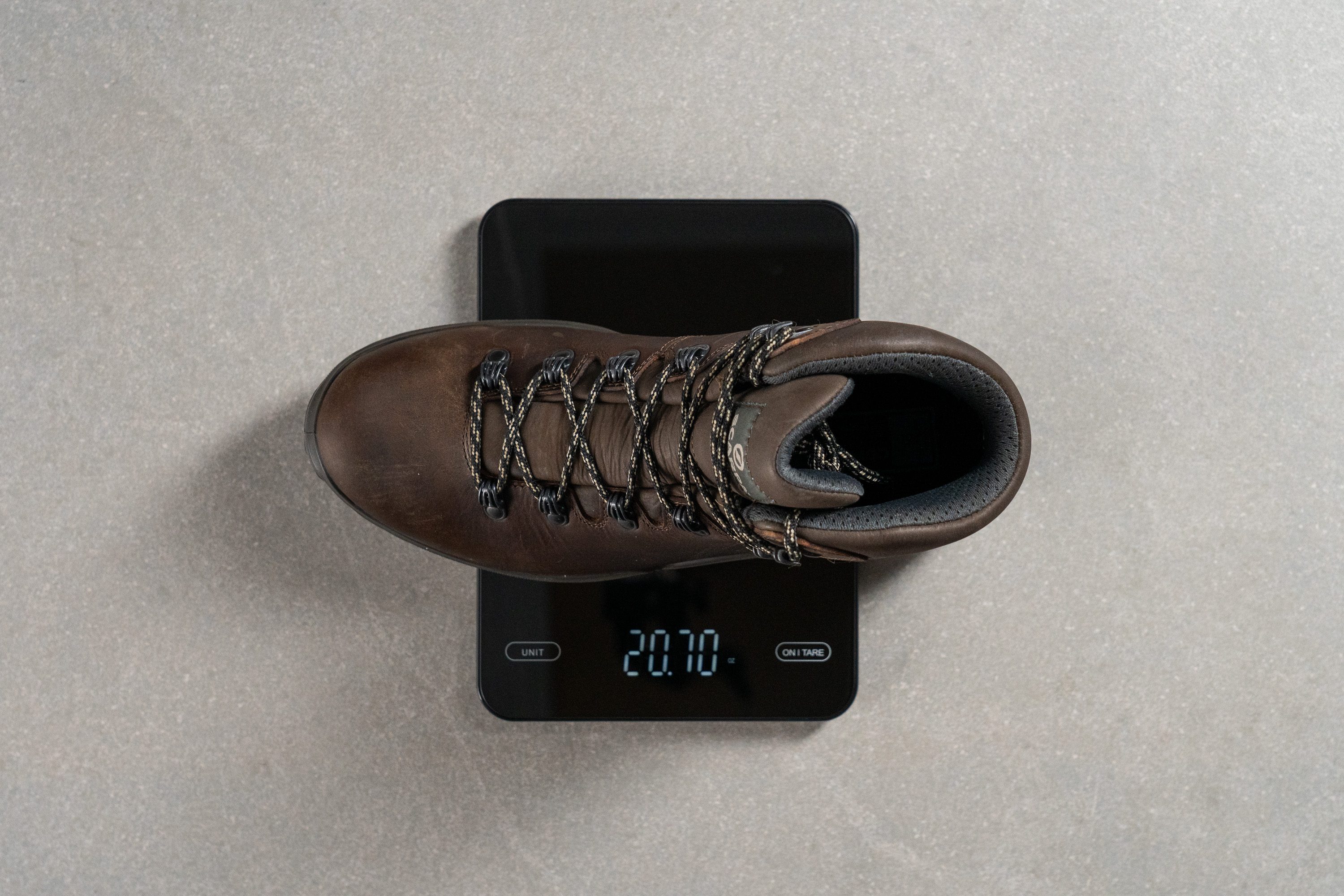
While this heft does contribute to how tank-like we feel while hiking in this boot, it does lead to fatigue and strain on our joints towards the end of our longer efforts and leaves us desperate to kick them off afterward.
| Terra GTX | 20.3 oz (575g) |
| Average | 18.7 oz (531g) |
Breathability
Good airflow isn't something we've come to expect from waterproof boots infused with Gore-Tex technology so the Terra GTX performed predictably in our smoke test. Not even a wisp of smoke was able to filter through the upper as we pumped it in, leading us to give the boot a breathability score of 1 out of 5.
Inspecting a backlit cross-section of the boot further confirms its well-insulated nature as it entirely eclipses our light below.
Looking like the surface of a mossy stone, our microscope image of the leather upper proves that it's perfectly solid and has no hidden pores that allow air or water into the boot.
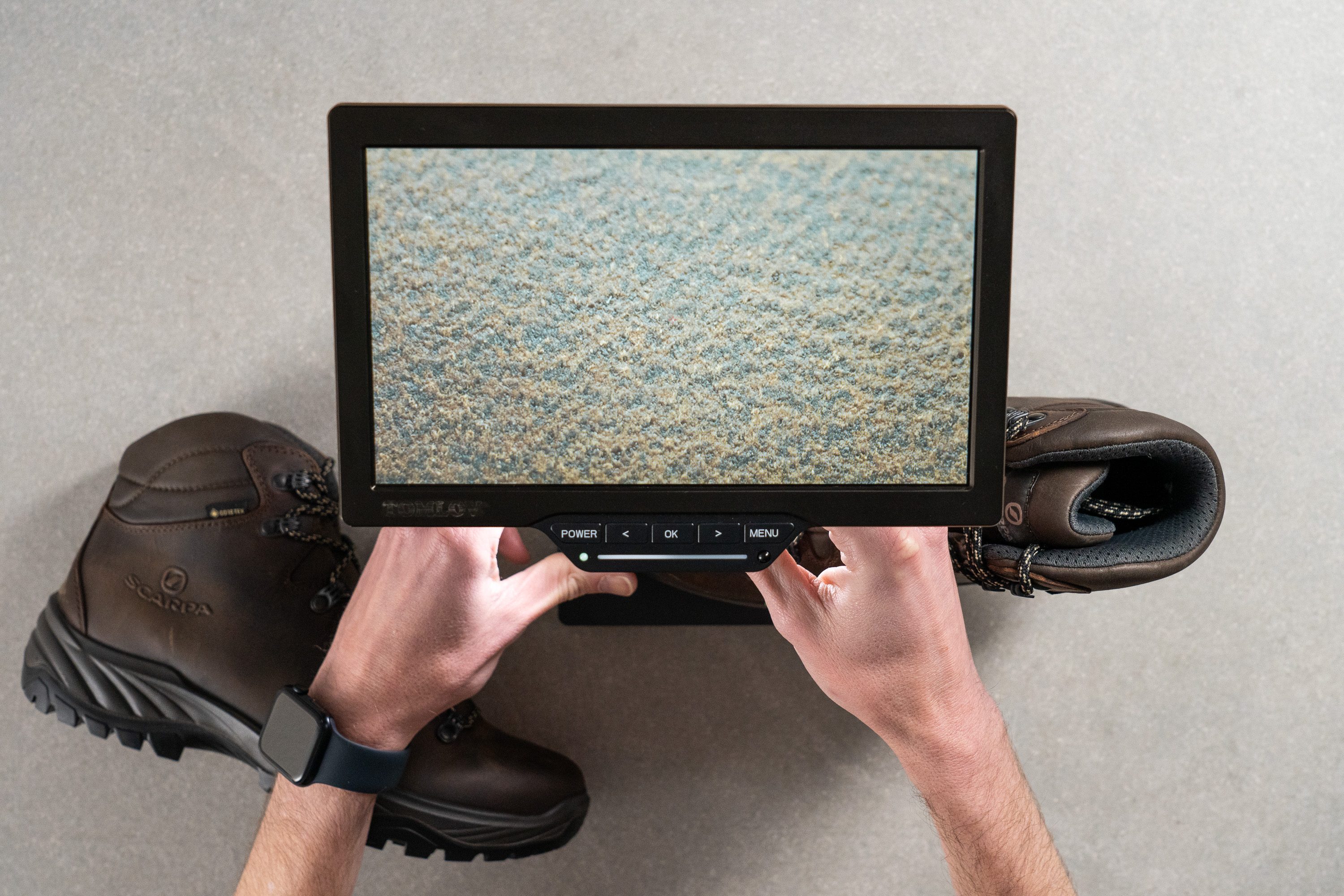
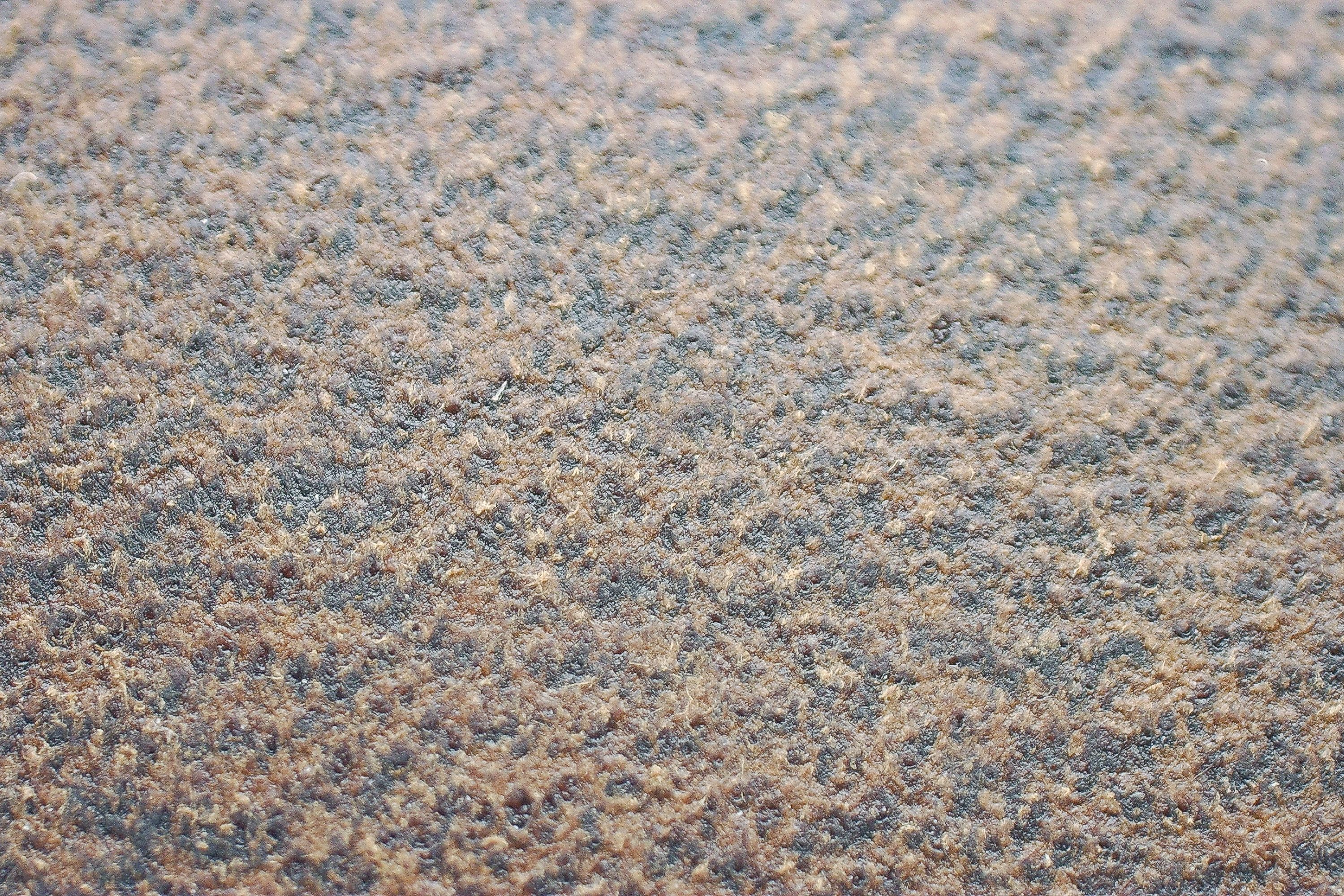
| Terra GTX | 1 |
| Average | 1.3 |
Stability
Lateral stability test
The Terra GTX feels incredibly well-planted as we take it out on the trails. Apart from the low stack of firm midsole foam, this stable sensation can also be attributed to the stiff TPU shank embedded in the boot's construction.
Torsional rigidity
The aforementioned shank lends the Terra GTX a high level of torsional rigidity which, in combination with the stiff leather upper, means that we could barely get the shoe to budge as we bent and twisted it manually. As such, the shoe resists the natural contortions of our foot and maintains a level base that promotes stable landings. This allows us to traipse up and down the trails without a wobble or thought of rolled ankles.
| Terra GTX | 5 |
| Average | 4.4 |
Heel counter stiffness
Moreover, the top of the boot tapers down slightly toward the rear heel portion of the boot. In this way, the Terra GTX still sits high enough around our ankle to feel supportive while limiting how much pressure the rigid external heel counter exerts on our Achilles tendon.
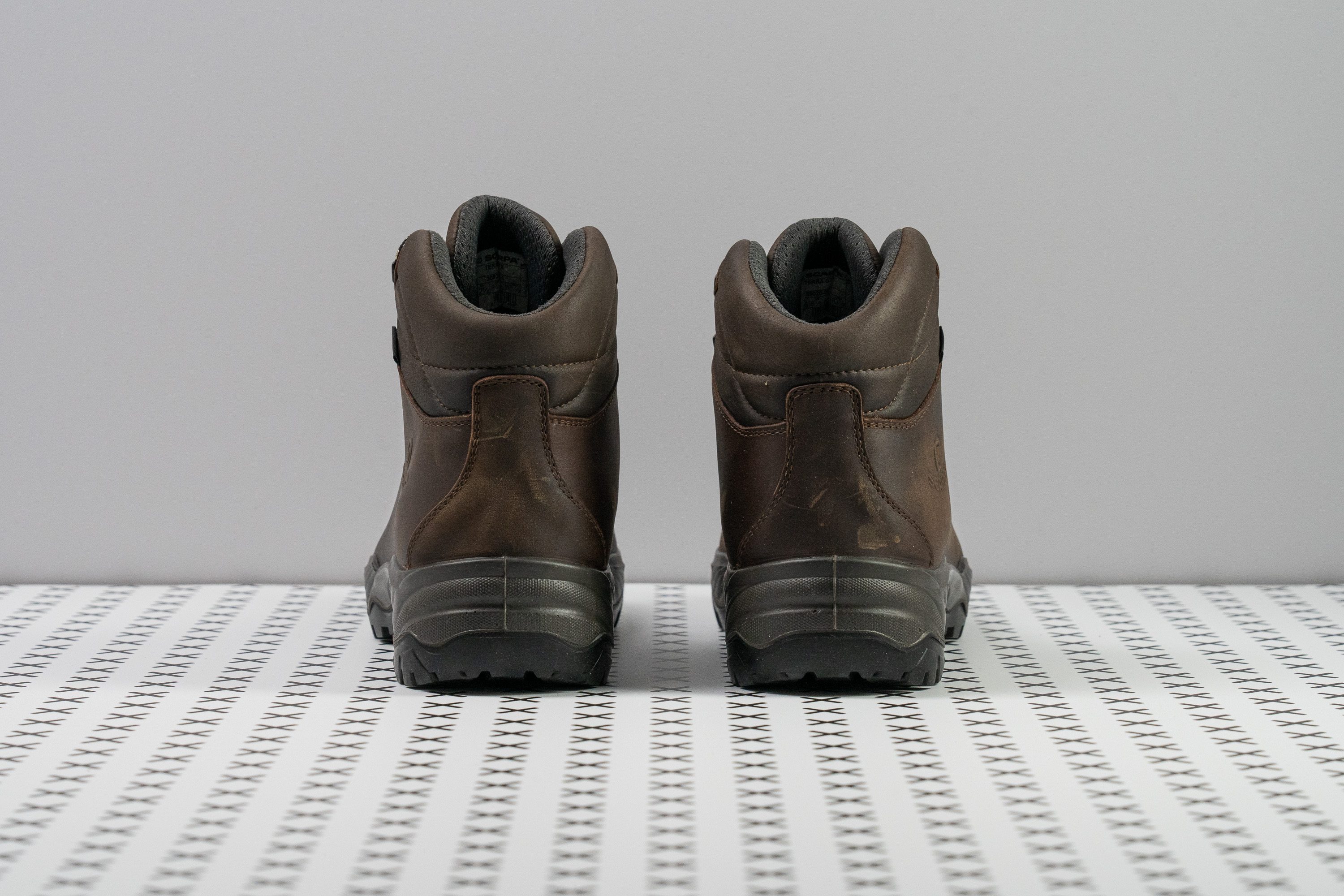
| Terra GTX | 4 |
| Average | 3.6 |
Midsole width - forefoot
Using our caliper, we measured the Terra GTX's midsole to be 110.5 mm wide. This is a little narrower than our current lab average but still leaves us with enough of a platform for stable landings and toe-offs without feeling too blocky.

| Terra GTX | 110.5 mm |
| Average | 111.5 mm |
Midsole width - heel
Back at the heel, the midsole is quite a bit narrower than average, at only 84.1 mm wide.

However, we found that, rather than sacrificing stability, this feature gives the boot a more agile silhouette that made it easier for us to maneuver over rocky terrains.
| Terra GTX | 84.1 mm |
| Average | 87.6 mm |
Durability
Toebox durability
To test the durability of the boot, we simulate extreme wear and tear by firing up our Dremel to 5K RPM and setting it against the Terra GTX's toebox with 3.2N of force. After twelve seconds of grinding, the toebox didn't suffer any real damage beyond a barely noticeable scuff.
This earns the Terra GTX a perfect toebox durability score of 5 out of 5. As such, we can scamper merrily and worry-free along the harshest trails knowing that the boot, and our fragile foot within, will stand up to any accidental bumps and scrapes along the way. That said, it will get scuffed up and bear the scars of adventures past.
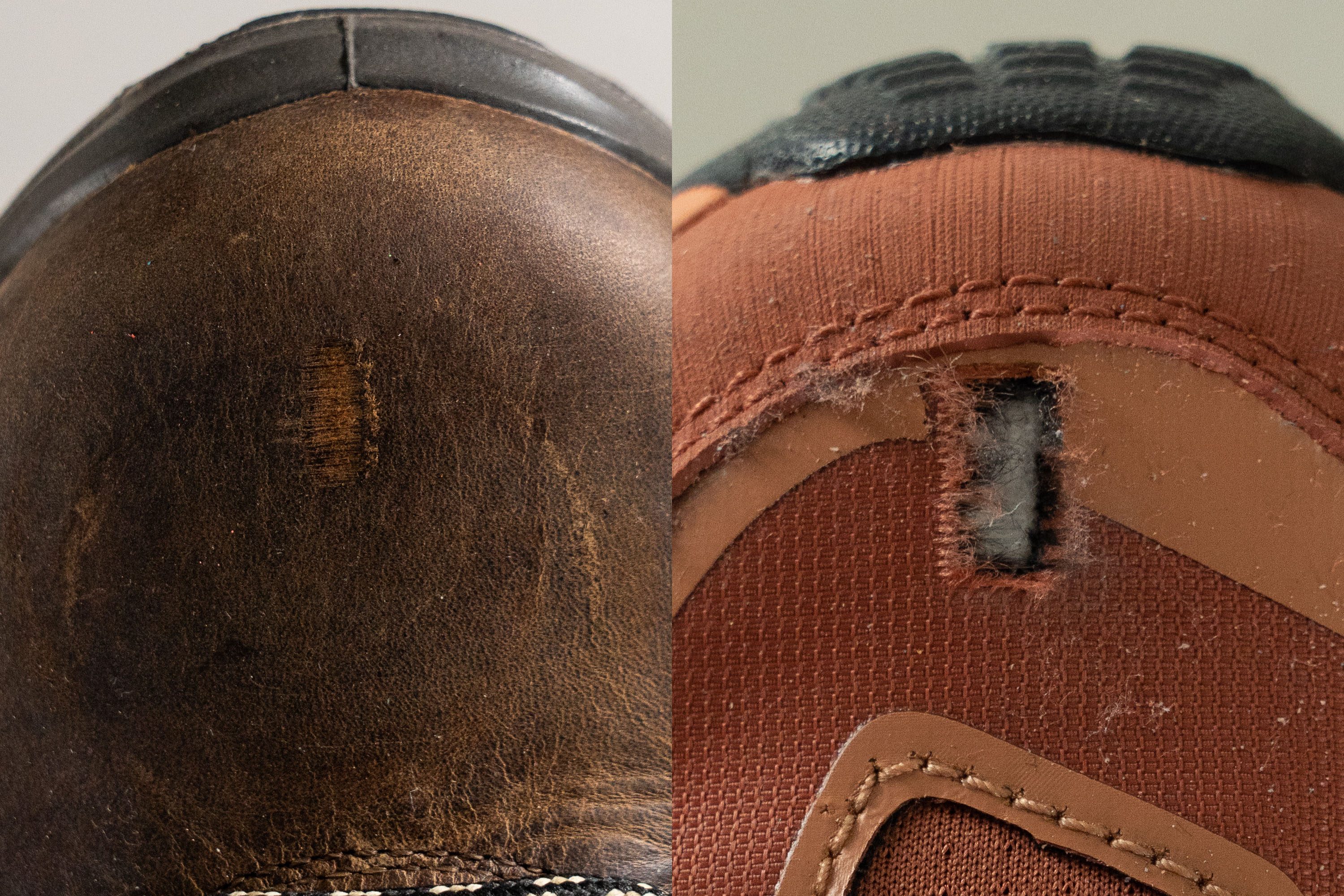
Not all Gore-Tex boots are built alike as the Hoka Anacapa Mid GTX clearly didn't fare nearly as well against our Dremel, making it better suited for milder trails with fewer hazards.
| Terra GTX | 5 |
| Average | 4.3 |
Heel padding durability
Next, we take aim at the shoe's comfy and well-padded heel collar and set our Dremel against the boot once more.
Once the four-second test was over, we found that the tool's abrasive element managed to fray the lining material but didn't do any significant damage beyond that. We therefore give the Terra GTX a very respectable heel padding durability score of 4 out of 5. This means that the boot will withstand the constant friction of heel rubs over long journies and should maintain and comfy and secure rearfoot lockdown throughout its lifetime.
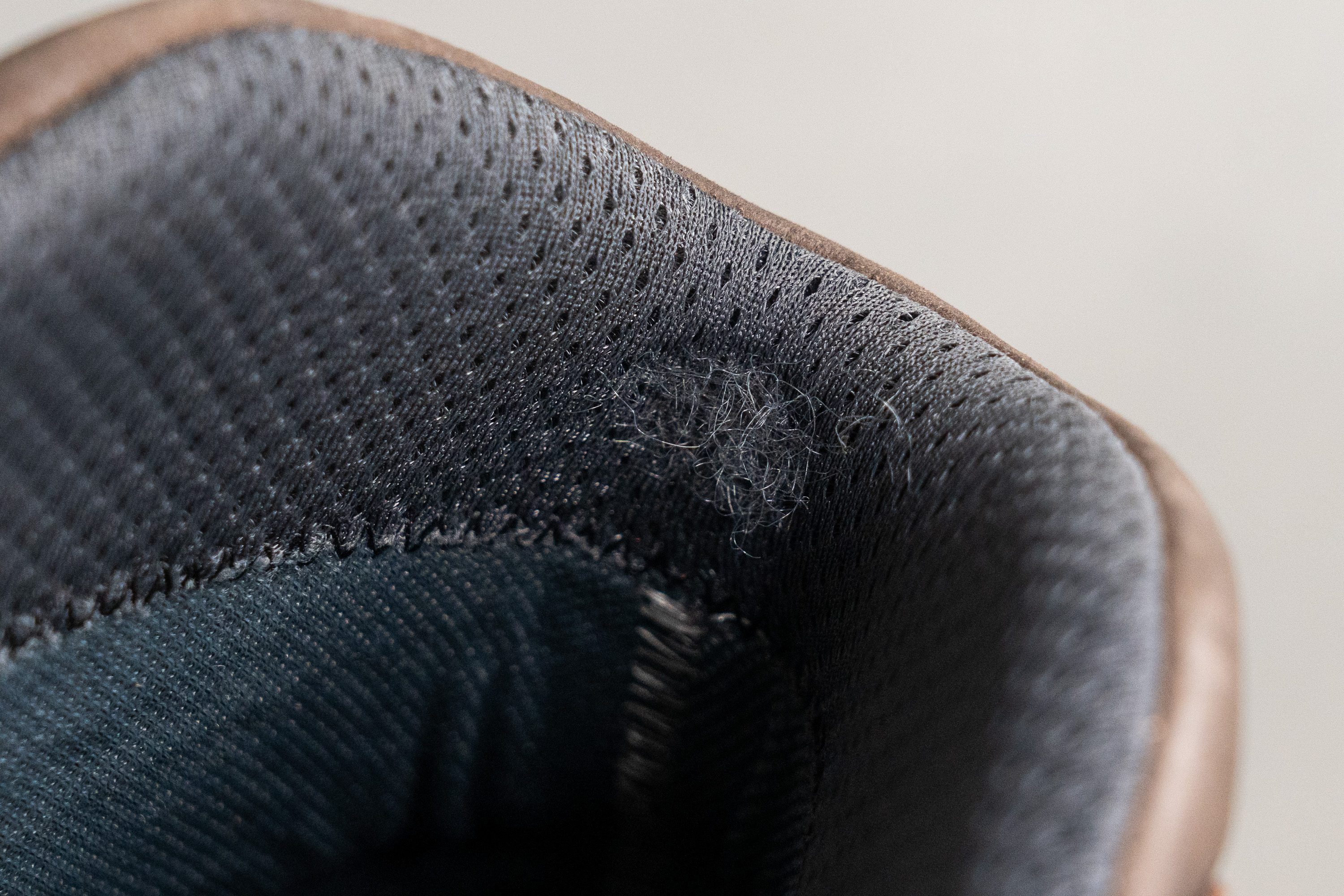
| Terra GTX | 4 |
| Average | 3.6 |
Outsole hardness
Pressing our durometer against the Terra GTX's Vibram outsole gives us a reading of 90.5 HC, making it about as hard as average for a hiking boot.
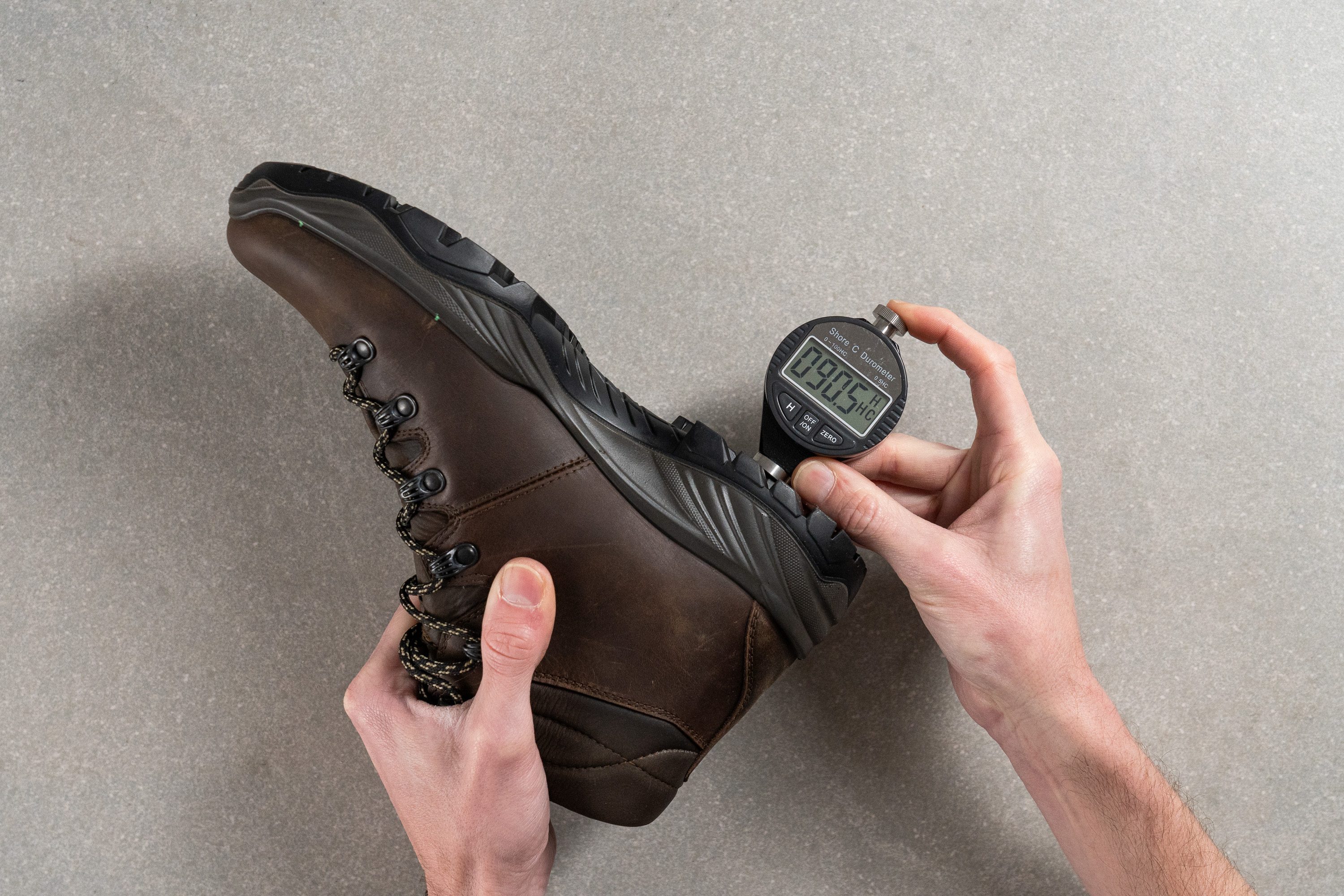
However, Vibram is renowned for making extremely grippy outsoles with durability to match, so we don't expect an average performance against our Dremel.
| Terra GTX | 90.5 HC |
| Average | 87.1 HC |
Outsole durability
This time spinning at a more formidable 10K RPM, we set our Dremel's abrasive element against one of the outsole lugs for twenty-two seconds of punishment.
However, as expected, our tool had minimal effect on the lug; leaving an indent only 0.5 mm deep. This is a very small fraction of the substantial amount of rubber this boot boasts underfoot, so we expect the Terra GTX to be a loyal companion for hundreds upon hundreds of miles of adventuring over any terrain before the outsole is kaput.

| Terra GTX | 0.5 mm |
| Average | 0.8 mm |
Outsole thickness
According to our caliper measurements, the outsole is slightly shorter than average at 2.7 mm thick. However, with the performance of the outsole material, this gives us no cause for concern regarding the longevity of this boot but does serve to shave off a little weight off an already heavy boot.

| Terra GTX | 2.7 mm |
| Average | 2.9 mm |
Misc
Insole thickness
At only 4.4 mm thick according to our caliper measurements, the Terra GTX's insole isn't quite as thick as average for hiking boots. It still provides a decently cushy footbed for our feet to sink into as we land.

| Terra GTX | 4.4 mm |
| Average | 6.0 mm |
Removable insole
The Terra GTX's insole isn't glued in, so replacing it with an aftermarket alternative or a custom orthotic is possible if necessary.
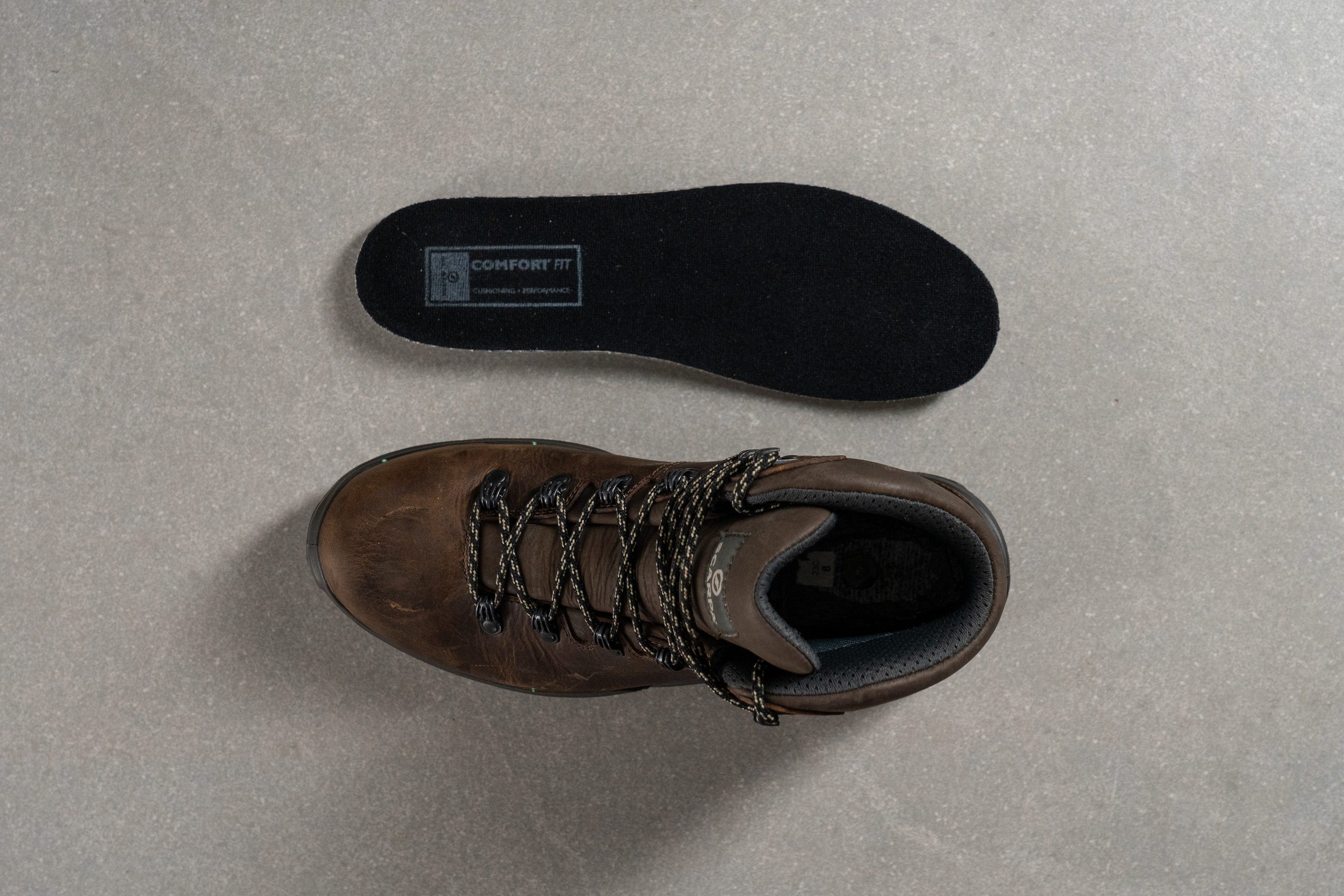
| Terra GTX | Yes |
Midsole softness in cold (%)
We placed the Terra GTX in our freezer for twenty minutes to simulate extreme cold conditions. Once appropriately chilled, we pressed our durometer against the midsole once more and found that it only became 15.7% more firm. So while it's still quite firm underfoot, it's a little more consistent than the average boot which stiffens up to a greater extent. As such, the midsole won't feel too different underfoot as the mercury drops
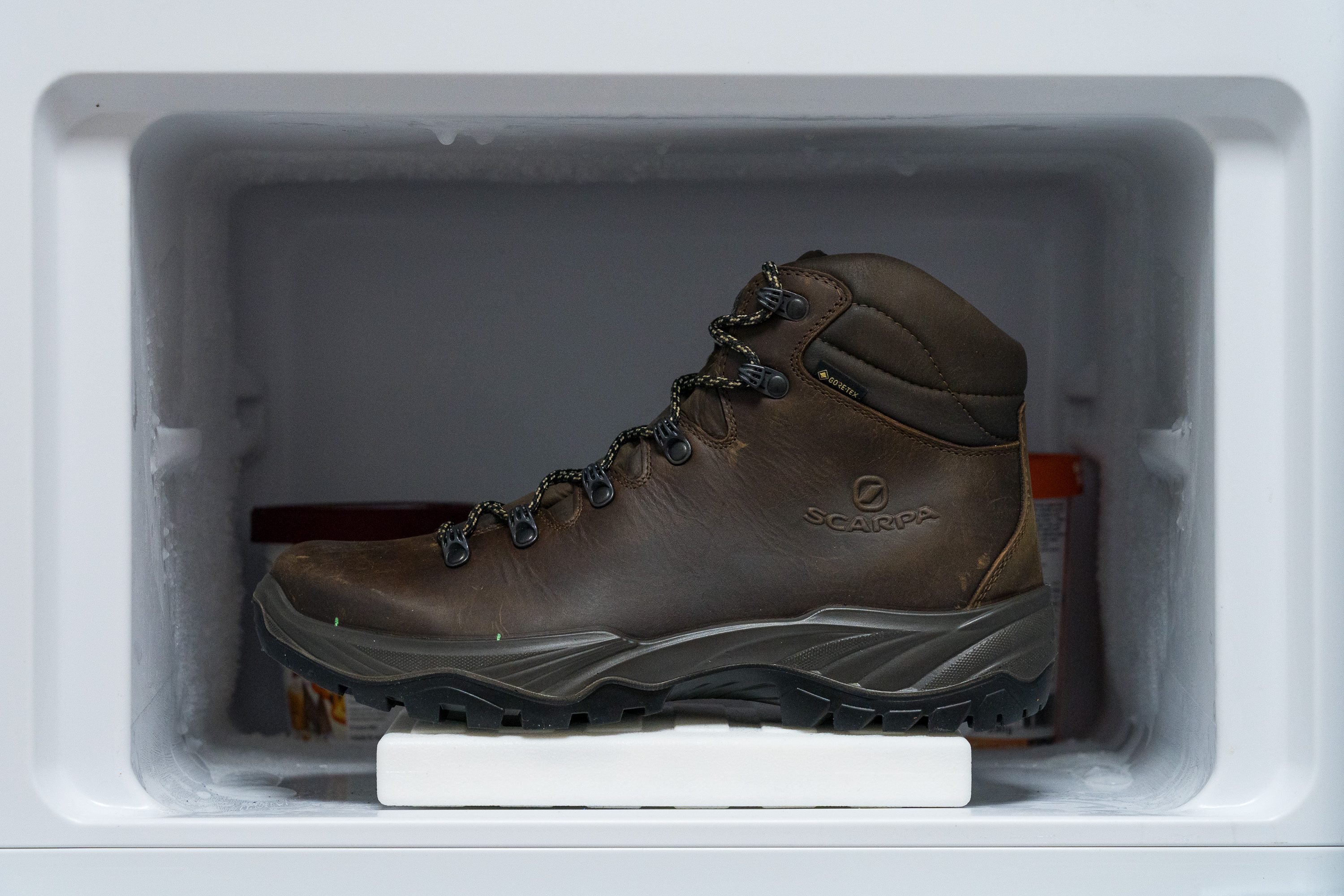
| Terra GTX | 16% |
| Average | 20% |
Reflective elements
There are no reflective elements to be found on the Terra GTX, so we advise against hiking alongside dimly lit roads without any additional high-vis gear.
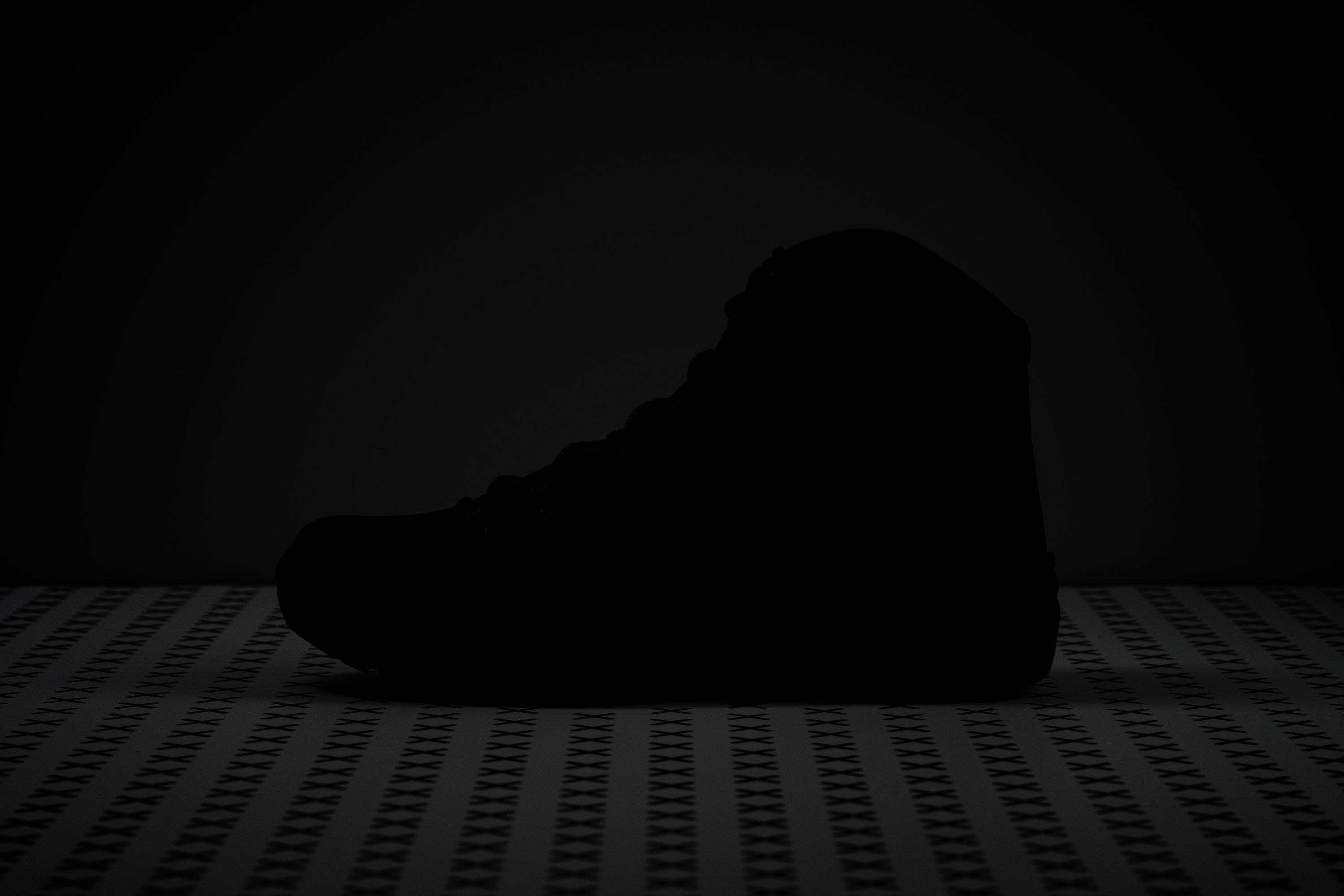
| Terra GTX | No |
Tongue padding
Using our caliper, we measured the Terra GTX's tongue to be 8.8 mm thick. While this makes it less padded than average, it still wraps around our instep very comfortably and effectively shields us from lace bite as we test the boot.
| Terra GTX | 8.8 mm |
| Average | 11.2 mm |
Tongue: gusset type
The Terra GTX's tongue is fully gusseted on both sides so we had no issues with bits of grit or debris making their way into the boot during our test hikes. It also meant that we had no issue with water seeping in under the laces as we splashed through shallow riverbeds.
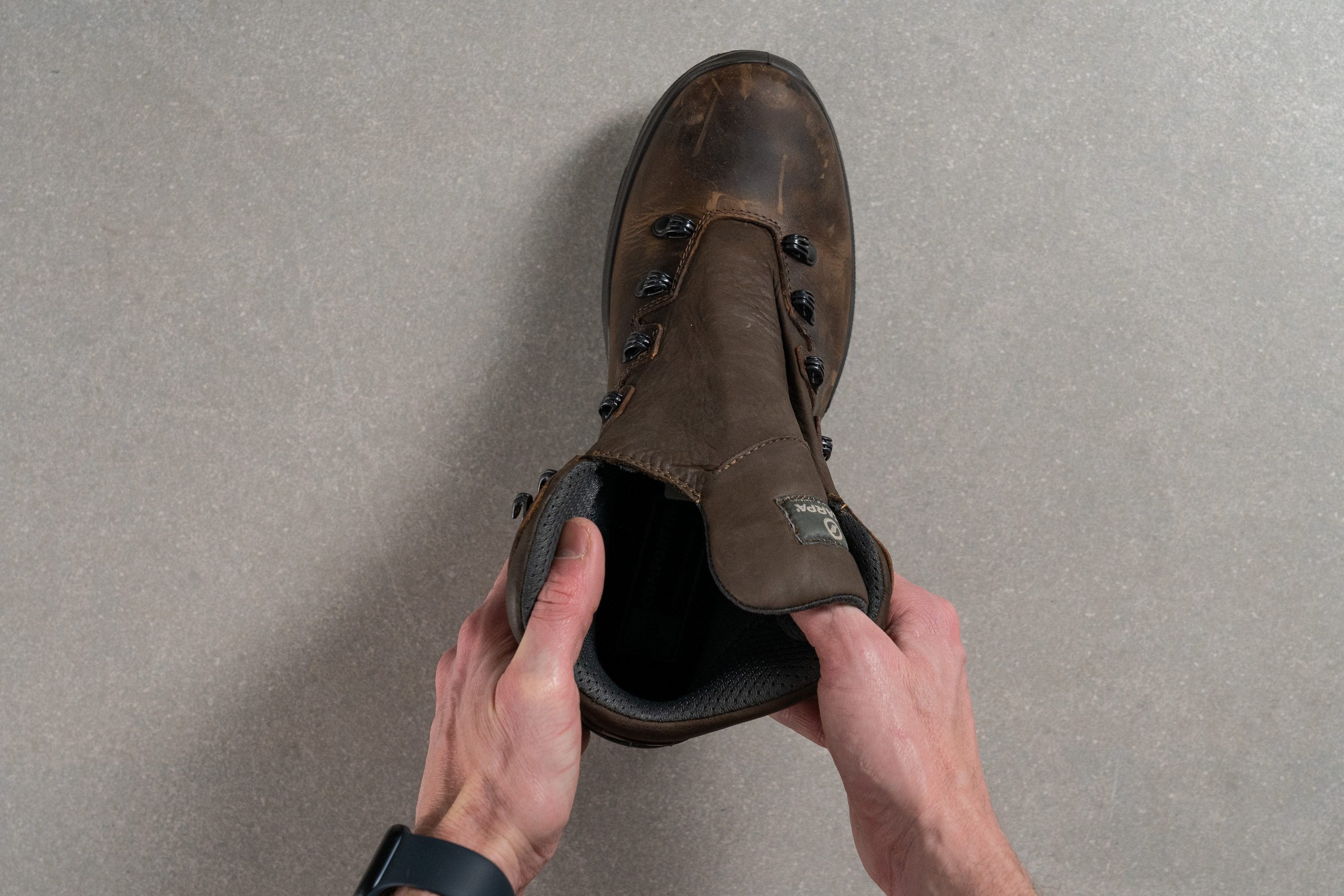
| Terra GTX | Both sides (full) |

